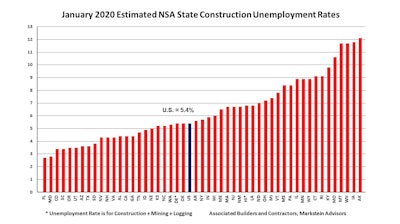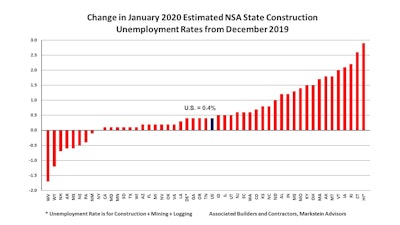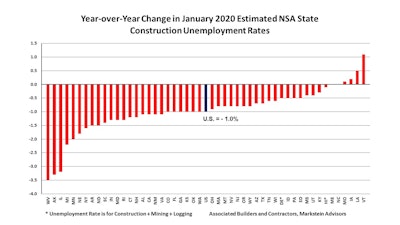
Estimated January not seasonally adjusted construction unemployment rates fell nationally and in 44 states, rose in four states and were unchanged in two states (Maine and North Carolina) on a year-over-year basis, according to an Associated Builders and Contractors (ABC) analysis of U.S. Bureau of Labor Statistics (BLS) data.
As of January 2020, the construction industry employed 172,000 more workers nationally compared to January 2019 while the national not seasonally adjusted (NSA) construction unemployment rate decreased from 6.4% to 5.4% over the same period, according to BLS numbers. This reversed the trend of declining year-over-year growth in construction employment, a sign of the underlying health of the construction industry prior to the outbreak of the coronavirus in the United States.
“In January, all of the country experienced above-average temperatures with the Northeast, from Wisconsin and Illinois eastward, registering significantly warmer than normal weather. This aided construction activity and employment,” said Bernard M. Markstein, Ph.D., president and chief economist of Markstein Advisors, who conducted the analysis for ABC. “These numbers were collected before it was known that COVID-19 was in the United States and precautions, such as select cities and Pennsylvania shutting down construction jobsites, were taken to prevent its spread. The larger effect of COVID-19 on construction unemployment won’t be reflected until the March and April data.”
 The national NSA construction unemployment rate increased 0.4% from December 2019 to January.Associated Builders and Contractors
The national NSA construction unemployment rate increased 0.4% from December 2019 to January.Associated Builders and Contractors
Because these industry-specific rates are not seasonally adjusted, national and state-level unemployment rates are best evaluated on a year-over-year basis. The monthly movement of rates still provides some information, although extra care must be used when drawing conclusions from these variations.
The national NSA construction unemployment rate increased 0.4% from December 2019 to January. Over the time since the data series began in 2000, the historical pattern always has been an increase in rates from December. Among the states, 41 had higher estimated construction unemployment rates than in December, while eight were lower and one was unchanged (New York). At the same time, the nation and 35 states posted their lowest January construction unemployment rate on record.
Top five states
The states with the lowest estimated NSA construction unemployment rates in order from lowest to highest were:
- Florida, 2.7%
- Maryland, 2.8%
- Colorado and South Carolina (tie), 3.4%
- Oregon and Utah (tie), 3.5%
All of these states except for Oregon were in the top five in December. For the second month in a row, Florida had the lowest construction unemployment rate among the states. This was also the state’s lowest January rate on record.
Maryland had the second lowest rate in January, the same as in December (tied with Colorado) based on revised data (originally reported as fifth lowest). This was the state’s lowest January rate on record.
Colorado and South Carolina tied for the third lowest rate in January. For Colorado, that was down from second lowest rate in December (tied with Maryland) based on revised data (originally reported as tied with Utah for third lowest). For South Carolina, this was up from the fourth lowest rate in December based on revised data (originally reported as second lowest). For both states, this was their lowest January rate on record.
Oregon and Utah tied for the fifth lowest rate in January. For Oregon, this was up from sixth lowest in December. This was the state’s lowest January rate on record. For Utah, this was the same ranking as in December based on revised data (originally reported as tied with Colorado for third lowest). This was Utah’s lowest January rate since posting a 2.6% rate in 2015.
 Associated Builders and Contractors
Associated Builders and Contractors
Bottom five states
The states with the highest estimated NSA construction unemployment rates in order from lowest to highest were:
- Missouri, 10.6%
- Montana and West Virginia (tie), 11.7%
- Iowa, 11.8%
- Alaska, 12.1%
All of these states except for Missouri were also in the bottom five in December. Alaska had the highest estimated construction unemployment rate in January, compared to second highest in December based on revised data (originally reported as third highest). Nonetheless, this was the state’s lowest January rate on record. Also, Alaska had the second largest year-over-year drop in its rate (behind West Virginia) among the states, down 3.3%.
Iowa had the second highest rate in January compared to fifth highest in December.
Montana and West Virginia tied for the third highest rate in January. For Montana, this compared to fourth highest in December. Still, this was the state’s second lowest January rate on record, behind the 7.3% rate in 2007. For West Virginia, this was an improvement from having the highest rate in December. This was the state’s lowest January rate on record. Further, West Virginia had the largest year-over-year and monthly decrease among the states, down 3.5% and 1.7%, respectively.
Missouri had the fifth highest rate in January compared to sixth highest in December.
Wyoming, which had the third highest rate in December based on revised data (originally reported as second highest), tied with Illinois and Minnesota for ninth highest in January with an 8.9% rate. This was the state’s lowest rate since the 6.6% rate in 2013

















